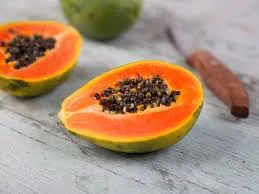Can a Dog Eat Papaya? A Detailed Guide Risk and Benefits
As pet owners, we often find joy in sharing our favorite foods with our furry companions. One such tropical delight that may pique your interest is papaya. With its sweet, juicy flavor and array of health benefits, you might wonder In this article, we’ll delve into the safety of feeding papaya to dogs, the nutritional benefits it offers, and how to incorporate this fruit into your dog’s diet safely.

What Is Papaya?
it is a tropical fruit native to Central America and the Caribbean, celebrated for its vibrant orange flesh and unique flavor. Rich in essential nutrients, papaya is a popular choice not only for its taste but also for its numerous health benefits for humans.
Nutritional Benefits
Before sharing papaya with your dog, it’s essential to understand what makes this fruit nutritious:
- Vitamins: it is an excellent source of vitamin C, which supports the immune system and promotes healthy skin. It also contains vitamin A, which is vital for eye health.
- Digestive Enzymes: One of the standout features of papaya is its enzyme called papain, which aids digestion. This enzyme can be particularly beneficial for dogs with digestive issues, helping break down proteins effectively.
- Fiber: Papaya is high in dietary fiber, promoting healthy digestion and regular bowel movements. This can be advantageous for dogs who may suffer from constipation.
- Antioxidants: The fruit is rich in antioxidants that can help combat oxidative stress in dogs, potentially reducing the risk of chronic diseases.
Can Dogs Eat Papaya?
Yes, dogs can safely eat papaya, provided it is prepared correctly and given in moderation. However, it’s important to be aware of some precautions before introducing this fruit into your dog’s diet.
1. Remove the Seeds and Skin
Seeds: seeds can pose a choking hazard and may cause intestinal blockages if swallowed. Additionally, while they contain some beneficial properties, consuming too many can lead to digestive issues. Always ensure the seeds are completely removed before offering papaya to your dog.
Skin: While the skin is not toxic, it can be tough for dogs to digest. Peeling the fruit before serving will make it easier for your dog to enjoy and reduce the risk of gastrointestinal upset.
2. Introduce in Moderation
Even though papaya is a nutritious fruit, it is essential to offer it in moderation. Dogs have different digestive systems than humans, and excessive consumption of fruit can lead to upset stomachs, diarrhea, or other gastrointestinal discomfort. Start with small amounts to gauge how your dog reacts.
How to Safely Introduce Papaya to Your Dog
If you decide to incorporate papaya into your dog’s diet, here’s how to do it safely:
- Wash Thoroughly: Rinse the papaya under running water to remove any pesticides or dirt from the surface.
- Peel and Cut: Peel the fruit and cut it into small, bite-sized pieces. This makes it easier for your dog to eat and prevents choking.
- Start Small: Offer your dog a small piece of papaya to see how they respond. Monitor them for any signs of discomfort or allergic reactions.
- Observe Reactions: After your dog consumes it, watch for any unusual behavior or symptoms, such as vomiting or diarrhea.
- Consult Your Veterinarian: If you have any concerns about feeding papaya or introducing new foods into your dog’s diet, it’s always wise to consult your veterinarian for personalized advice.
What to Do If Your Dog Eats Papaya Seeds
If your dog accidentally consumes a few papaya seeds, remain calm. While it’s best to avoid this situation, small amounts typically won’t cause immediate harm. However, take the following steps:
- Monitor Your Dog: Keep an eye on your dog for any signs of distress, such as choking, vomiting, diarrhea, or lethargy.
- Hydration: Ensure your dog has access to fresh water, as staying hydrated can help with digestion.
- Seek Veterinary Advice: If you notice concerning symptoms or if your dog has consumed a large number of seeds, contact your veterinarian for guidance.
Healthier Treat Alternatives
If you’re looking for other dog-friendly fruits to complement papaya, consider these options:
1. Blueberries
Blueberries are a fantastic, low-calorie treat that is high in antioxidants. Many dogs love their sweet, tangy flavor.
2. Apples
Apples are safe for dogs, provided the seeds and core are removed. They are rich in vitamins A and C, as well as fiber.
3. Carrots
Carrots are a healthy, crunchy snack that many dogs enjoy. They are low in calories and beneficial for dental health.
4. Watermelon
Seedless watermelon is hydrating and can be a refreshing treat for dogs, especially on hot days. Just be sure to remove the seeds and rind before serving.
5. Pumpkin
Plain canned pumpkin (not the spiced pie filling) is an excellent source of fiber and can help regulate your dog’s digestive system.
Conclusion
In conclusion, dogs can safely enjoy papaya when prepared properly and given in moderation. Always remove the seeds and skin, and start with small portions to monitor your dog’s reaction. If you have any doubts about introducing papaya or other fruits into your dog’s diet, consulting your veterinarian is the best way to ensure their health and safety.
By being informed and cautious, you can enjoy sharing this tropical fruit with your furry friend. Incorporating a variety of safe fruits into your dog’s diet not only enhances their nutrition but also keeps mealtime exciting. Understanding which foods are safe for dogs is an important aspect of responsible pet ownership, and sharing delicious treats like papaya can strengthen the bond between you and your pet while promoting their overall well-being.
